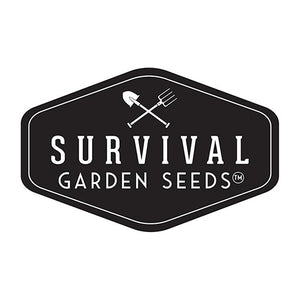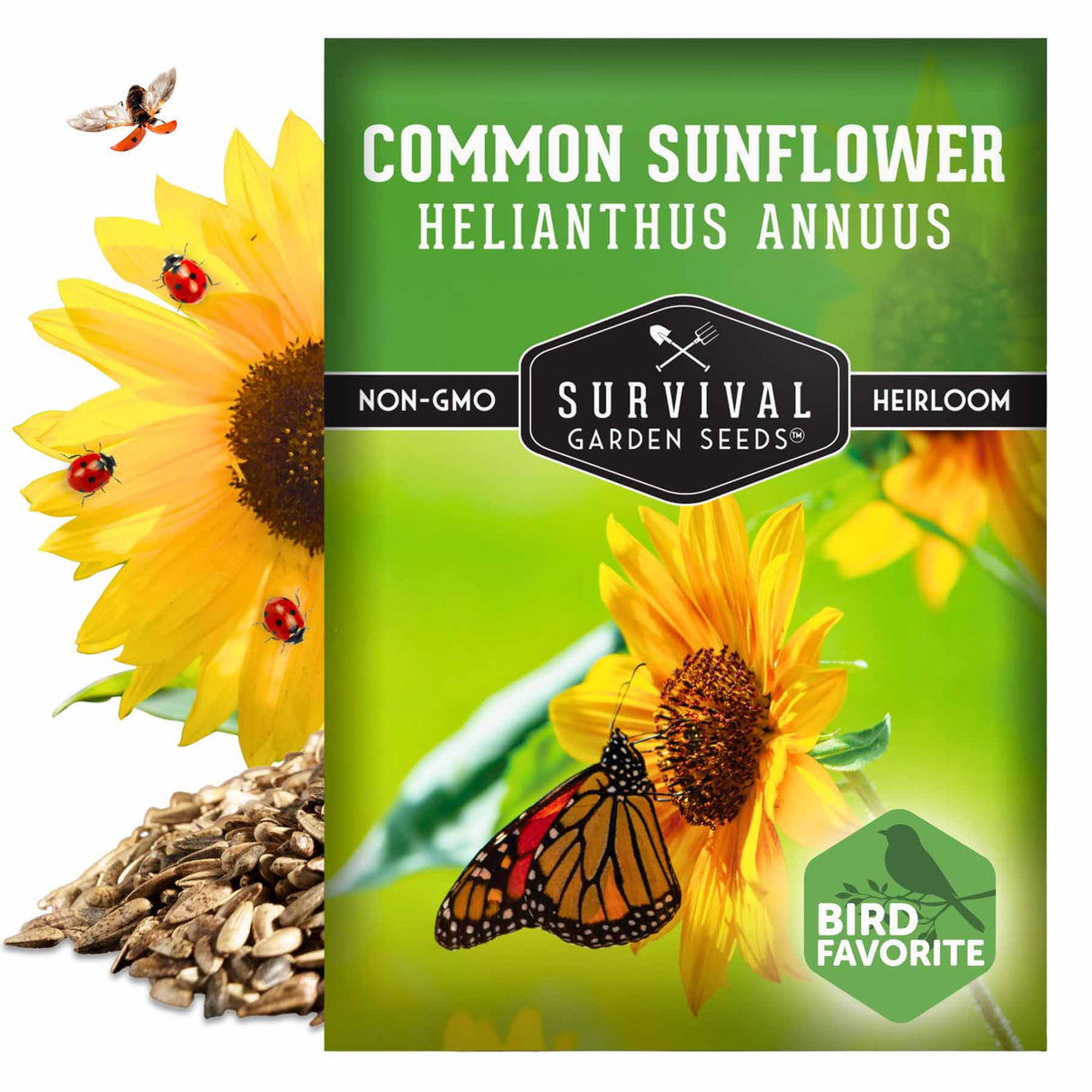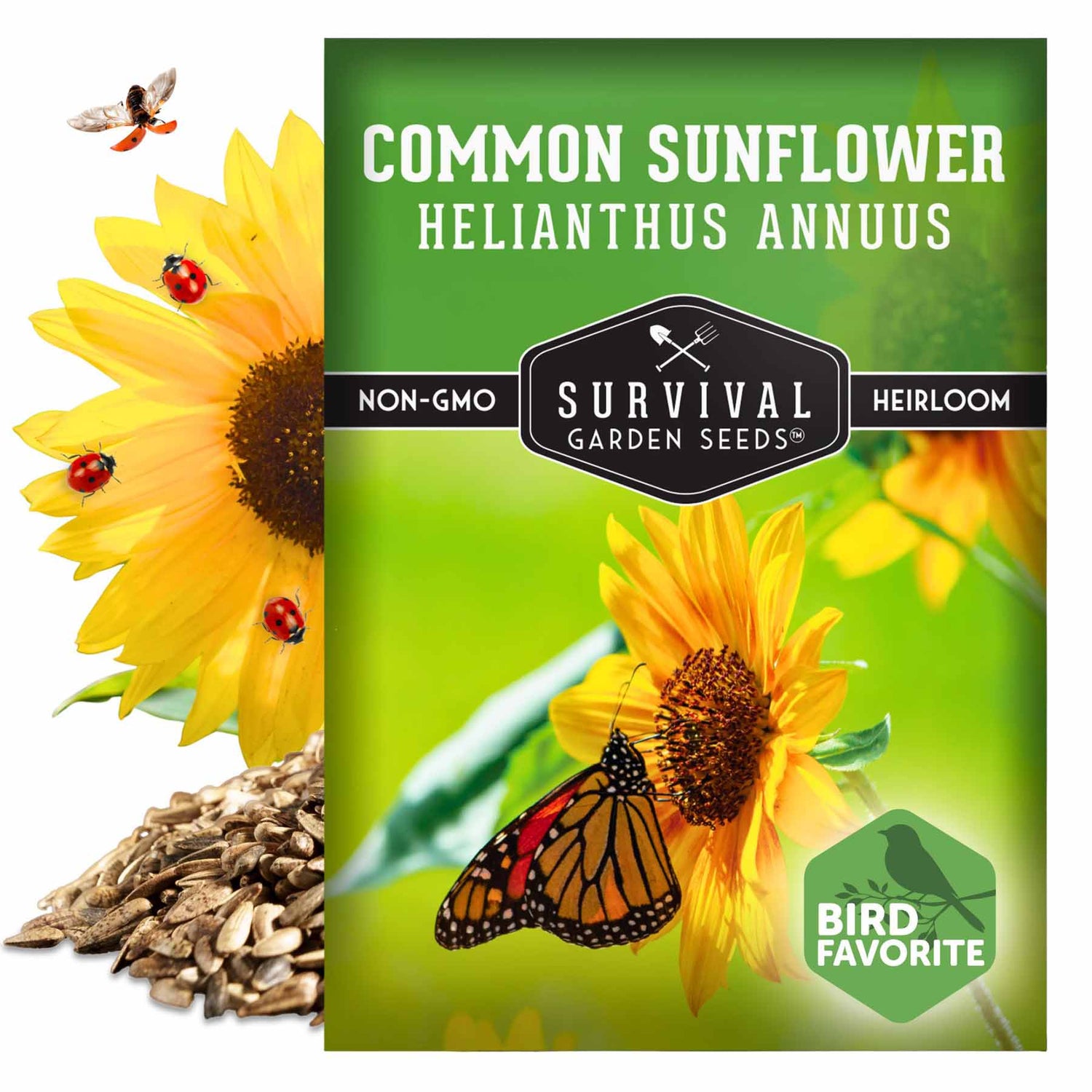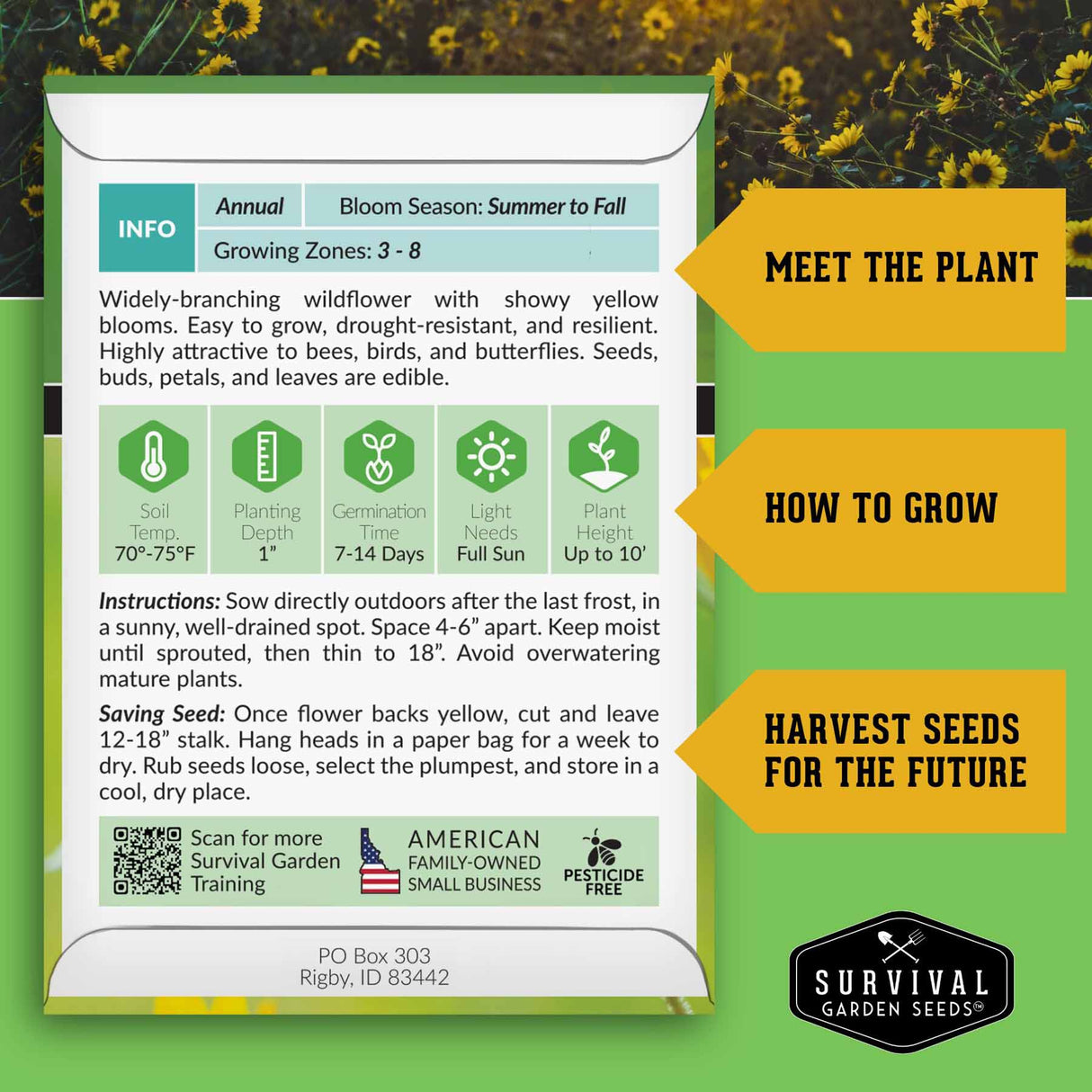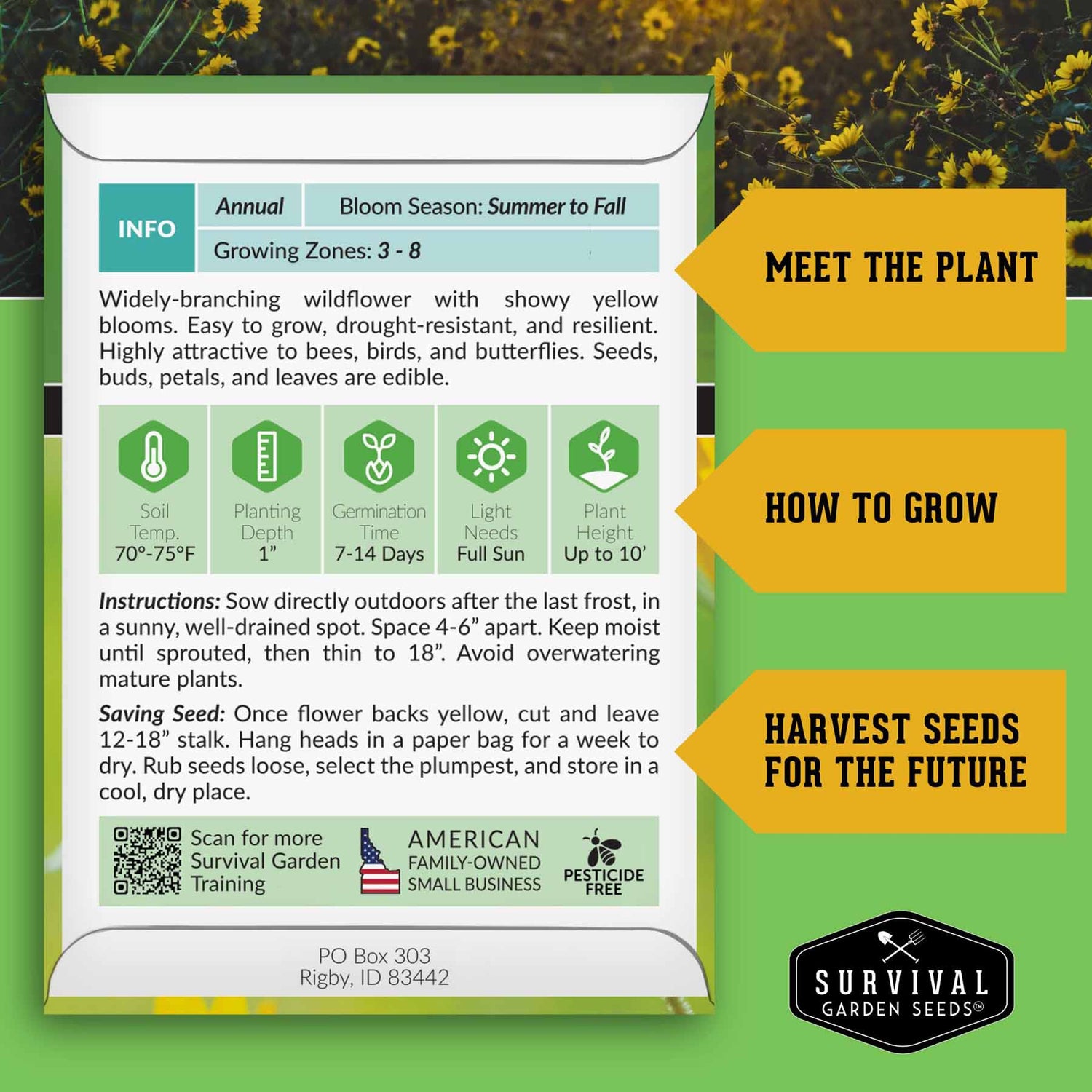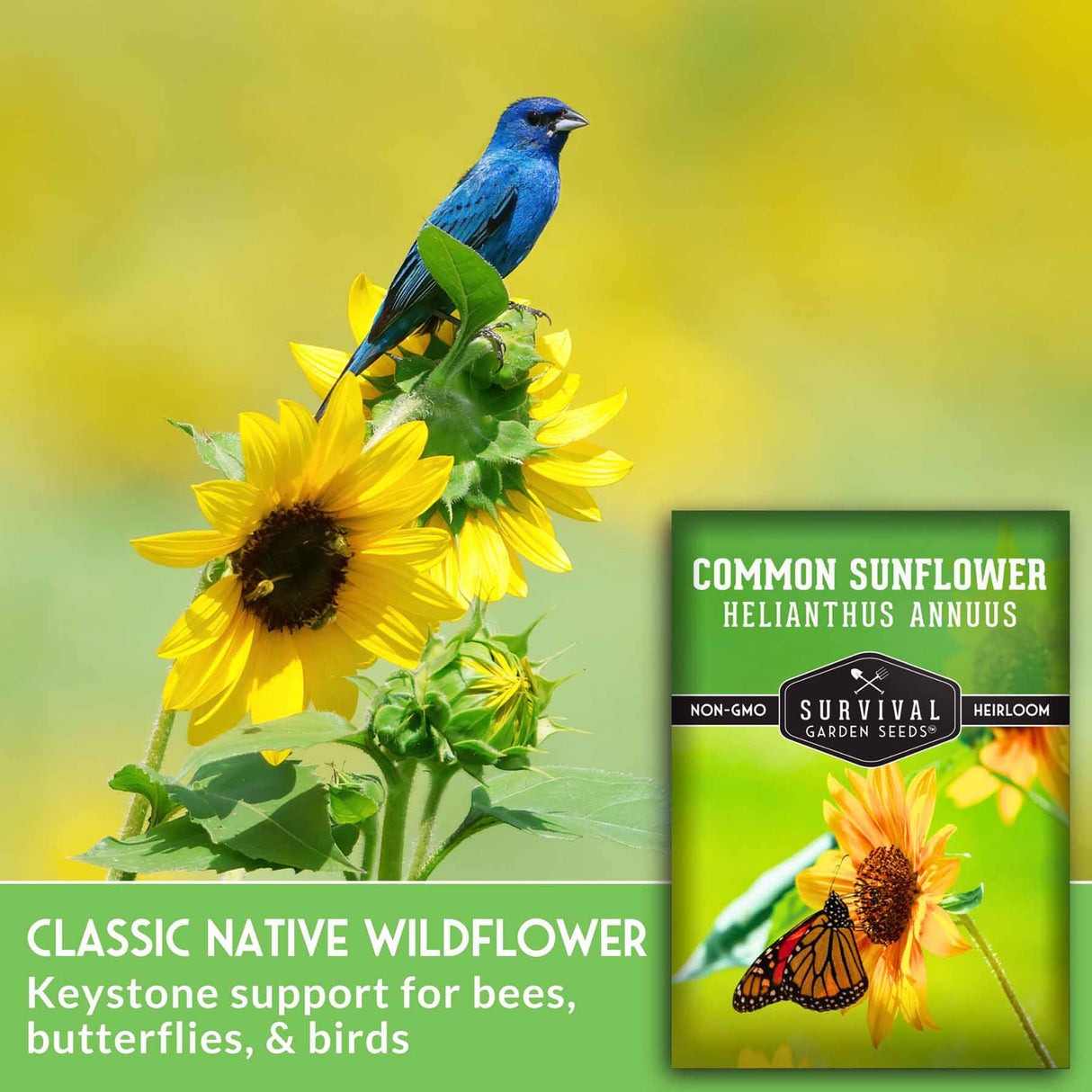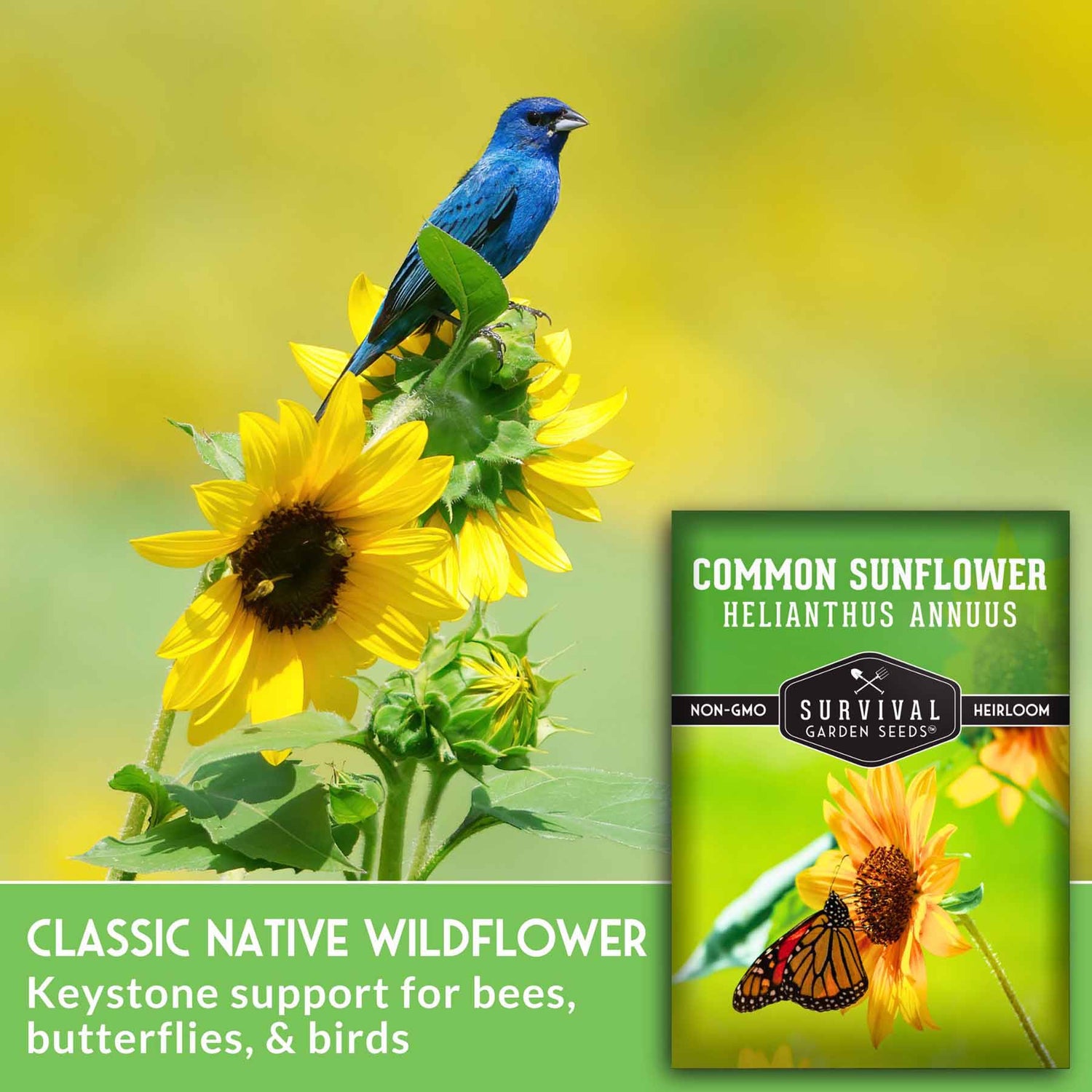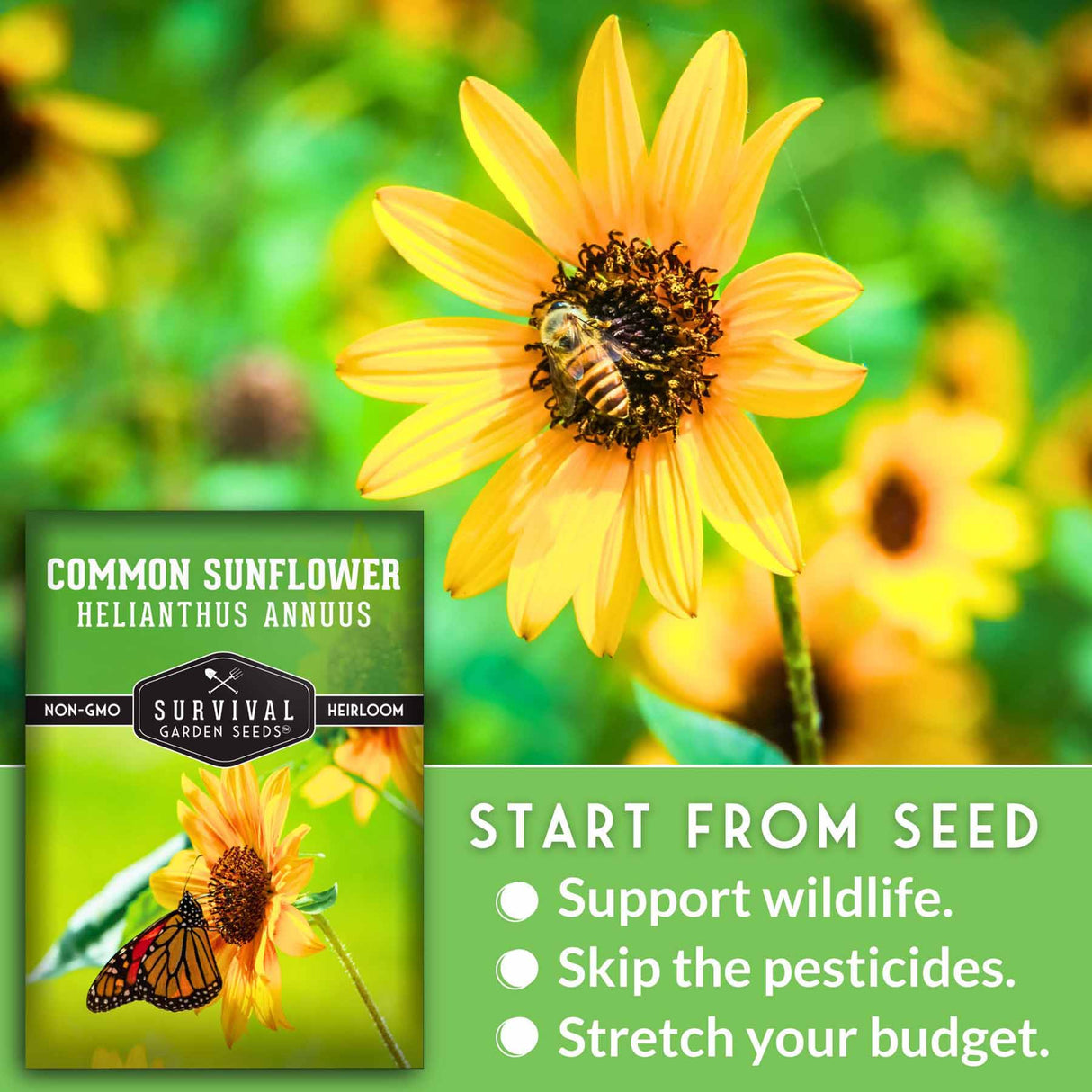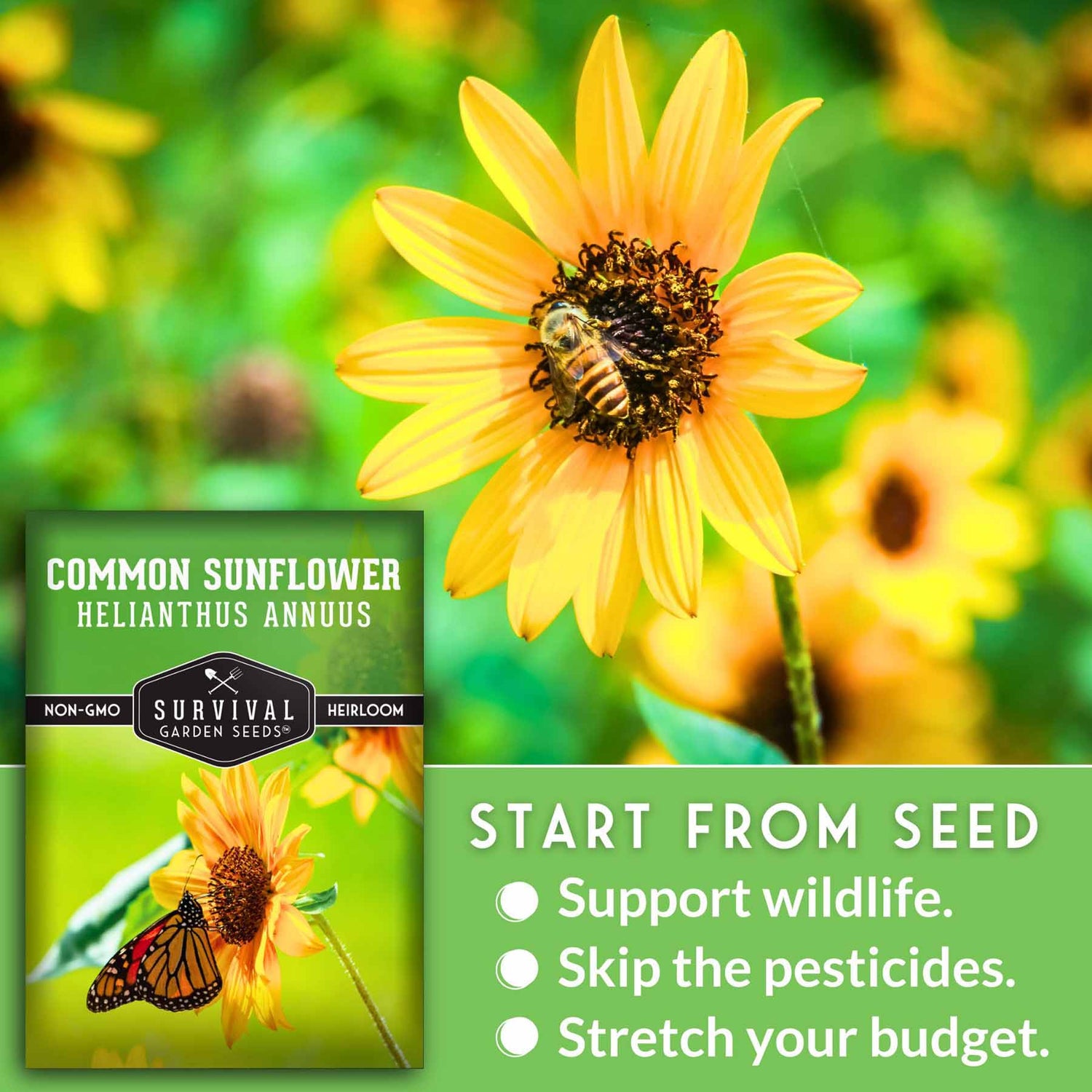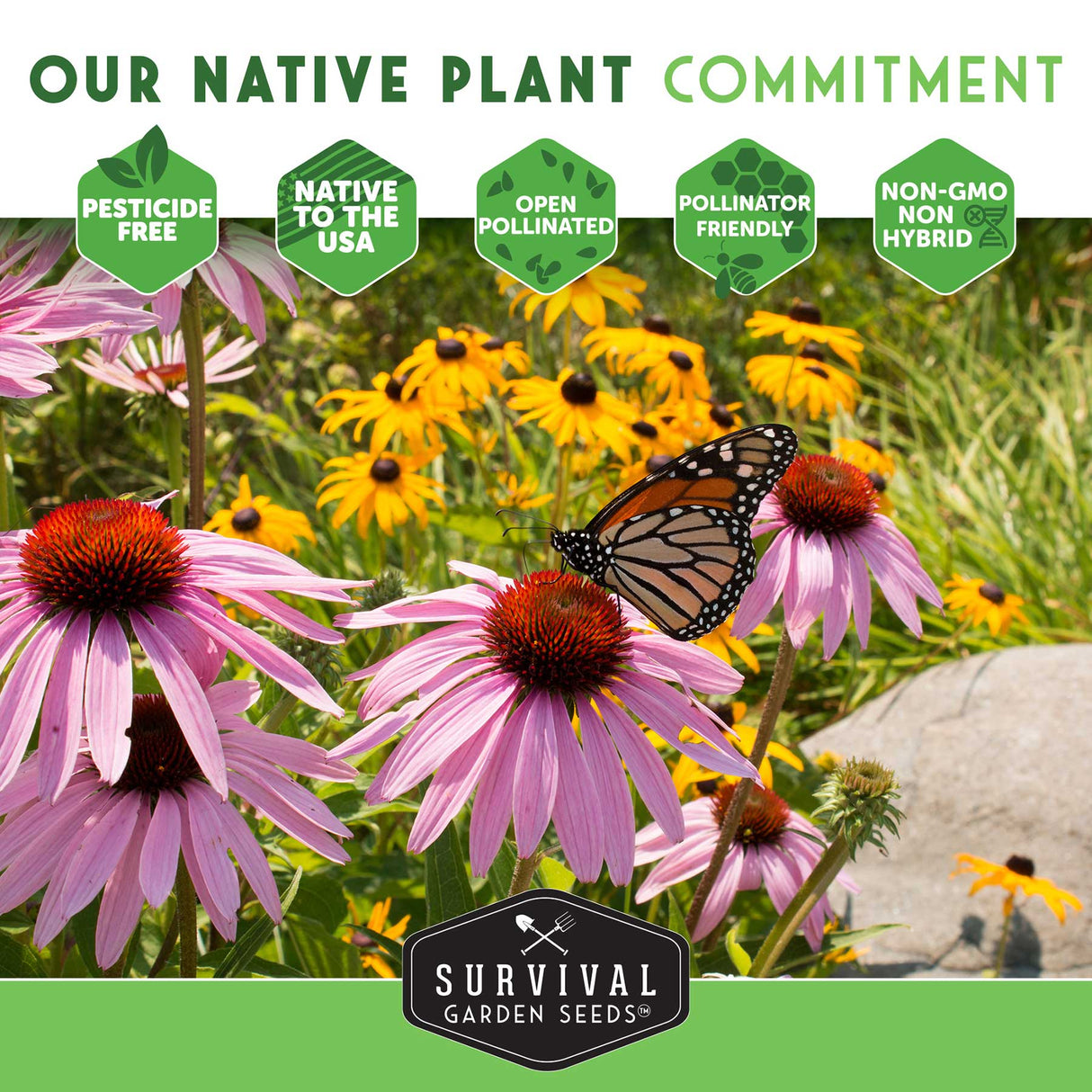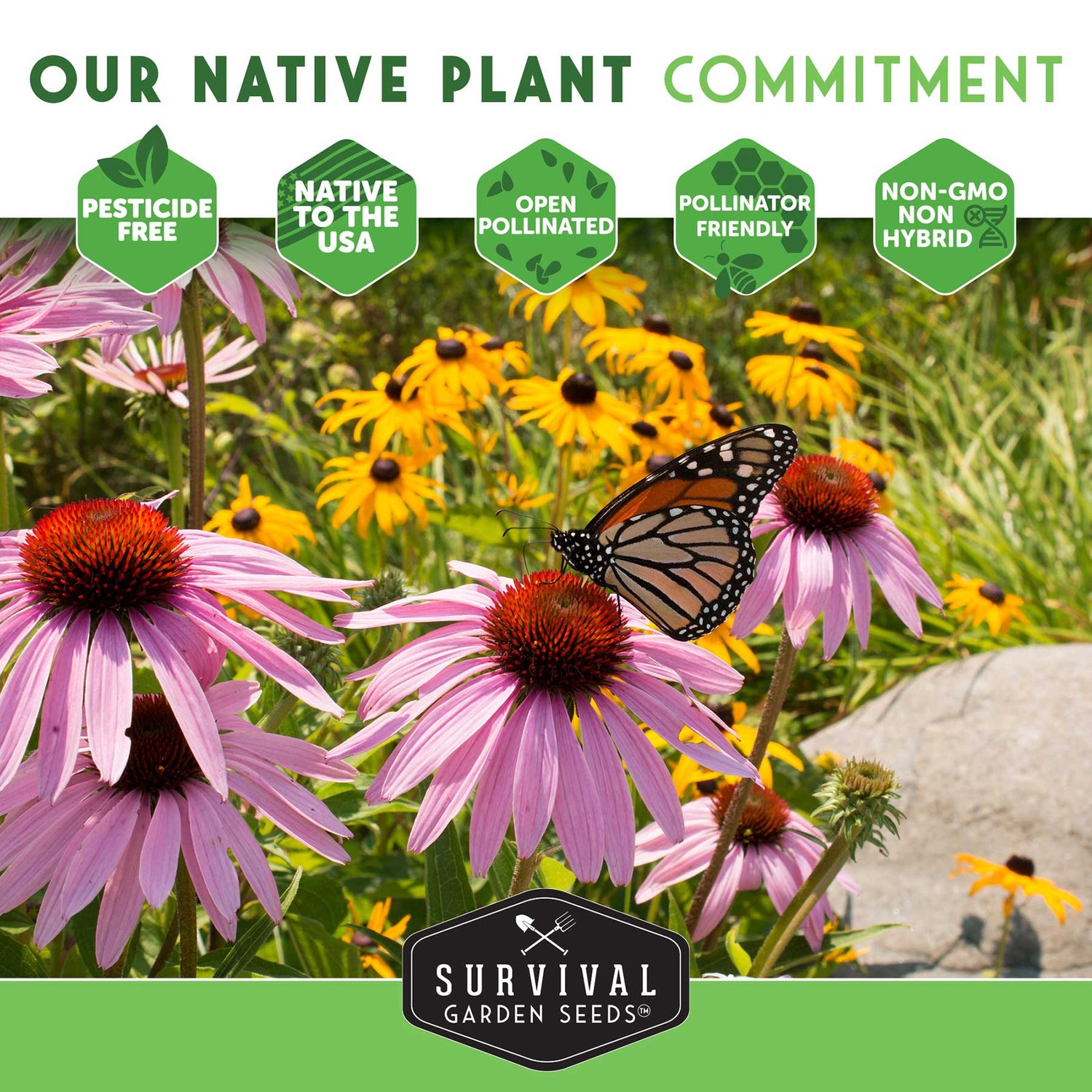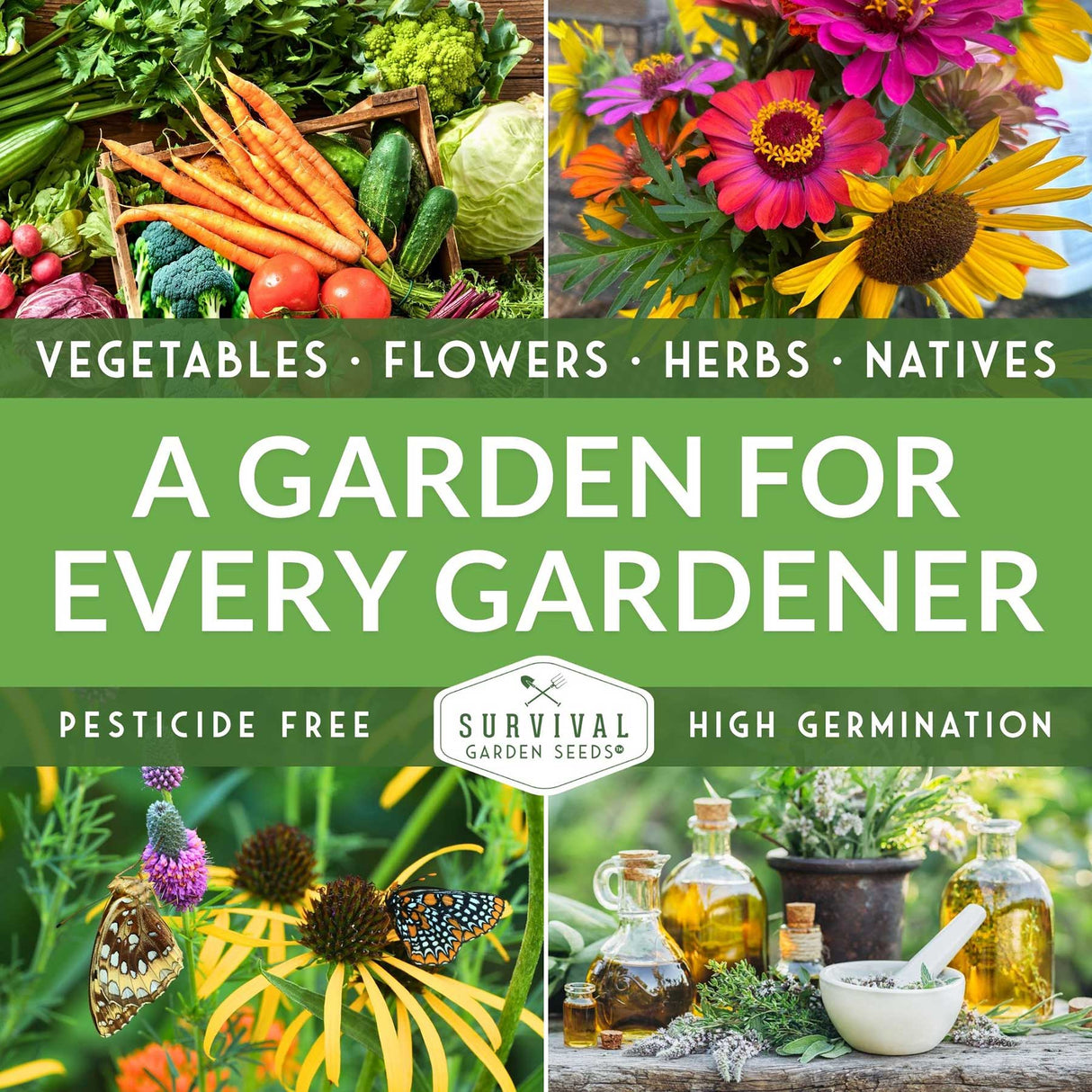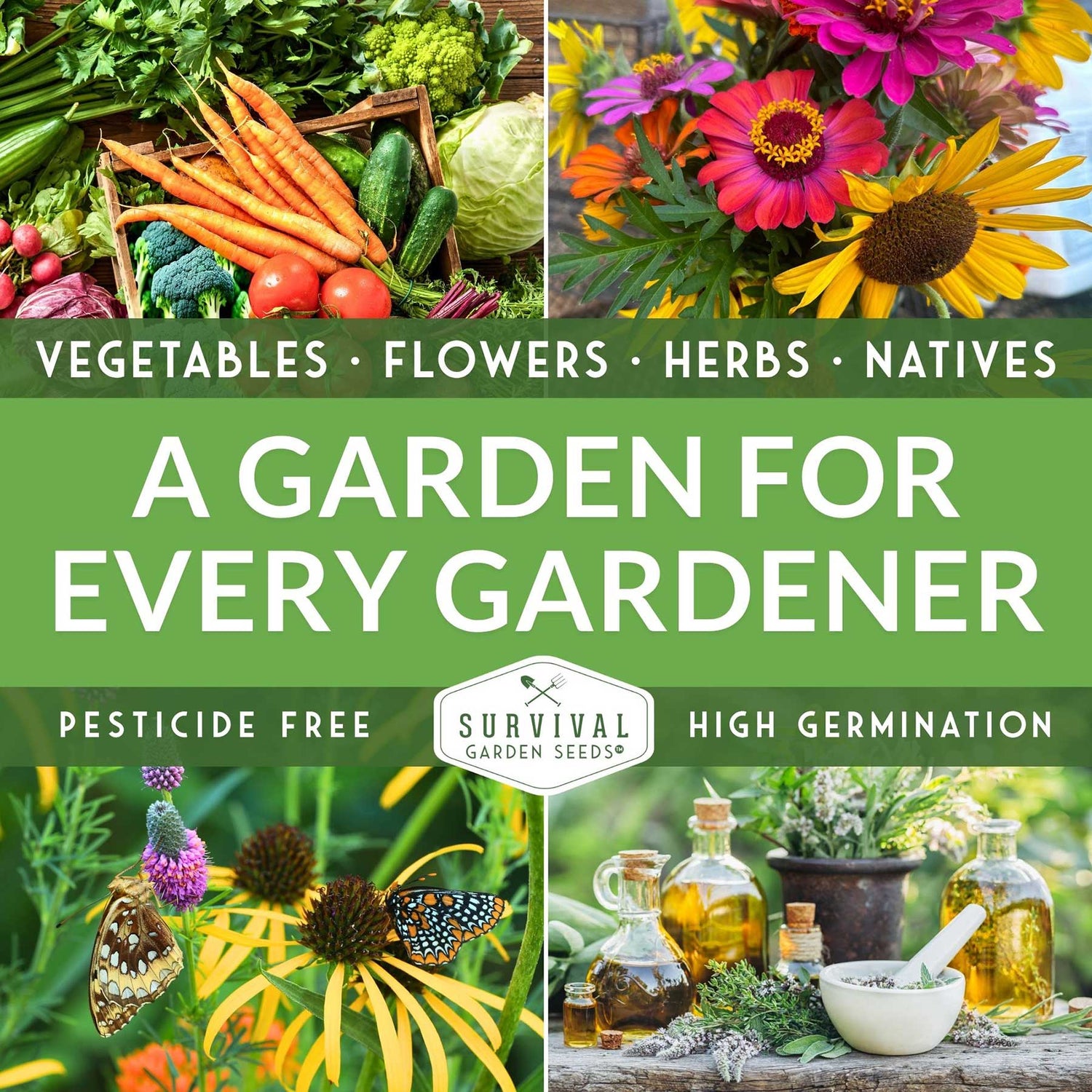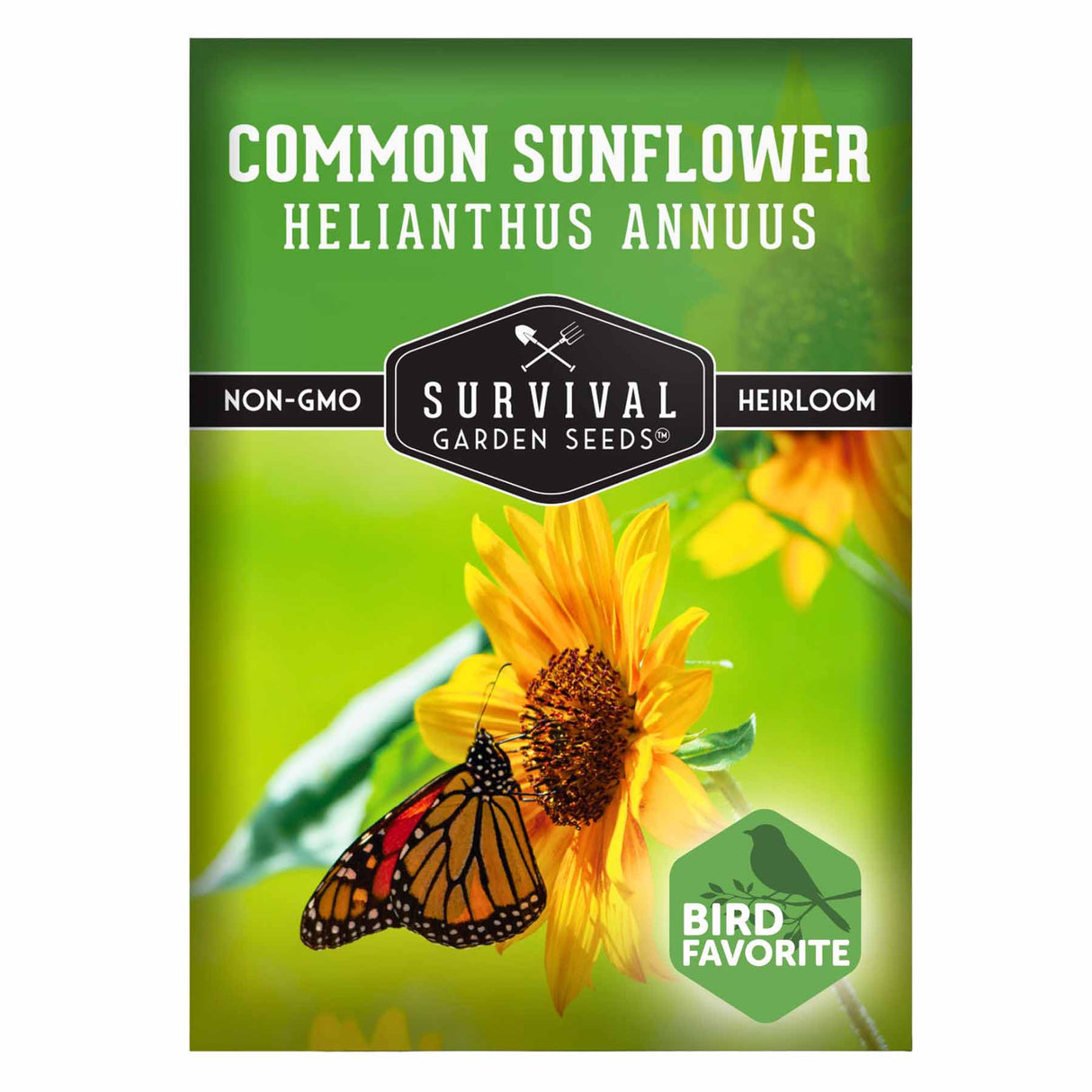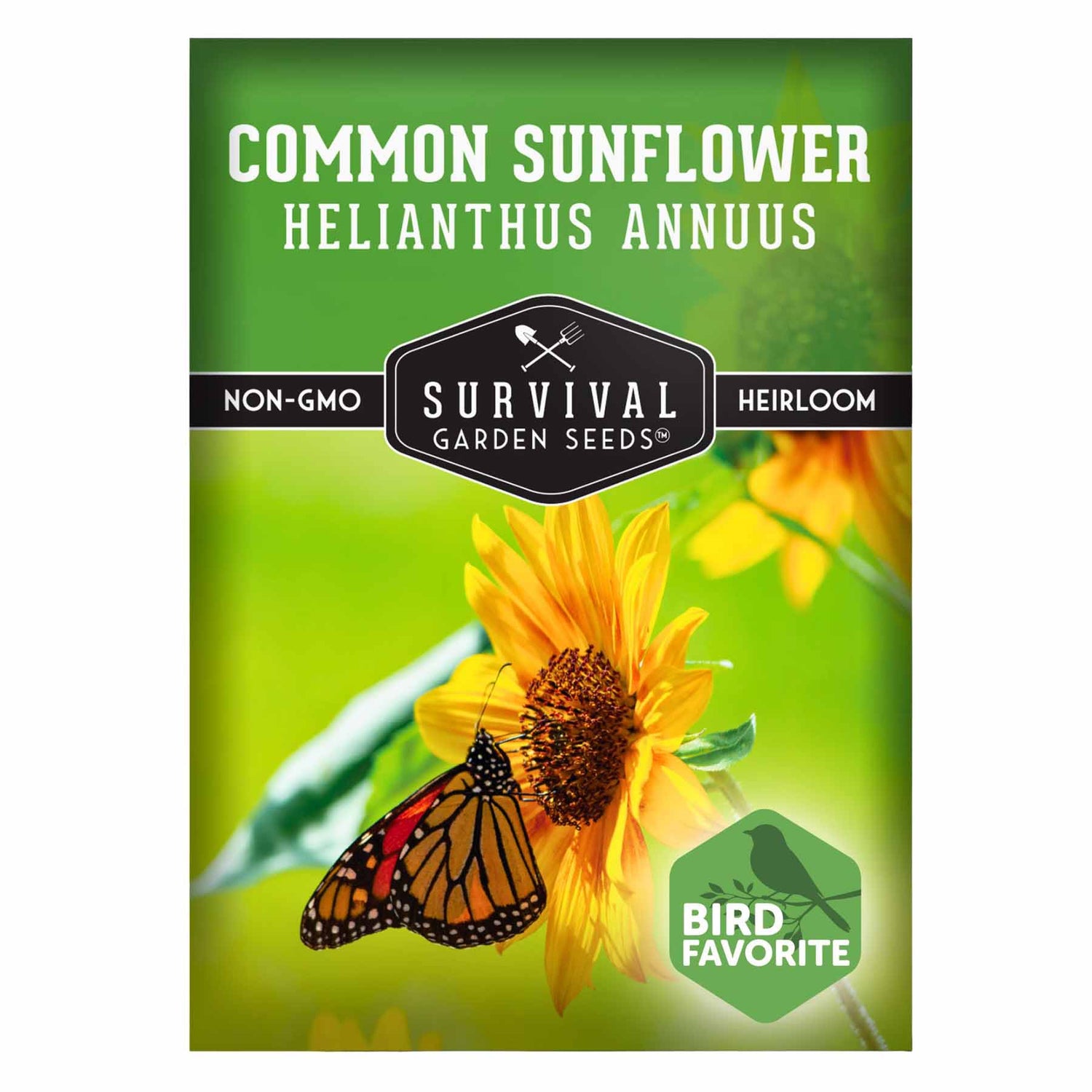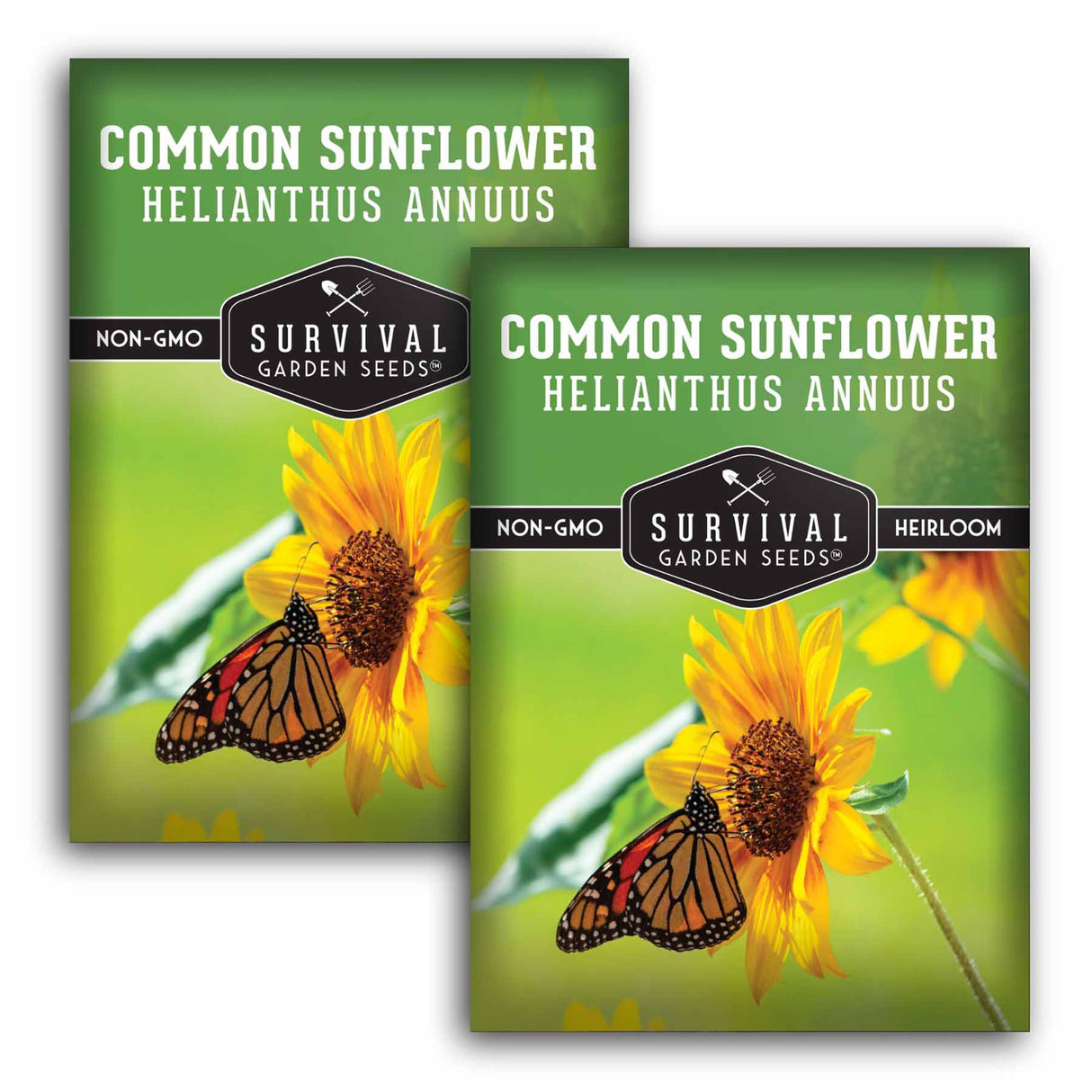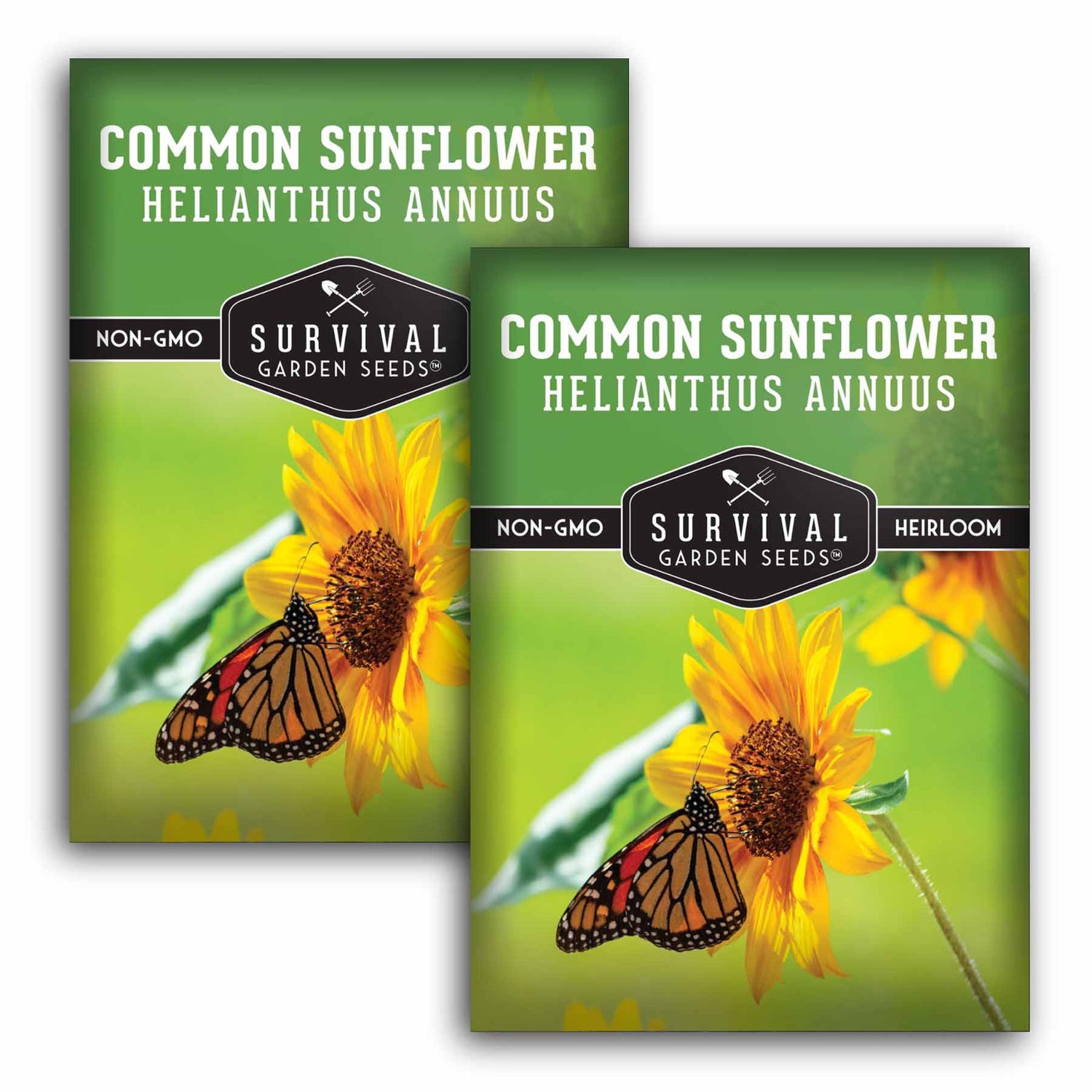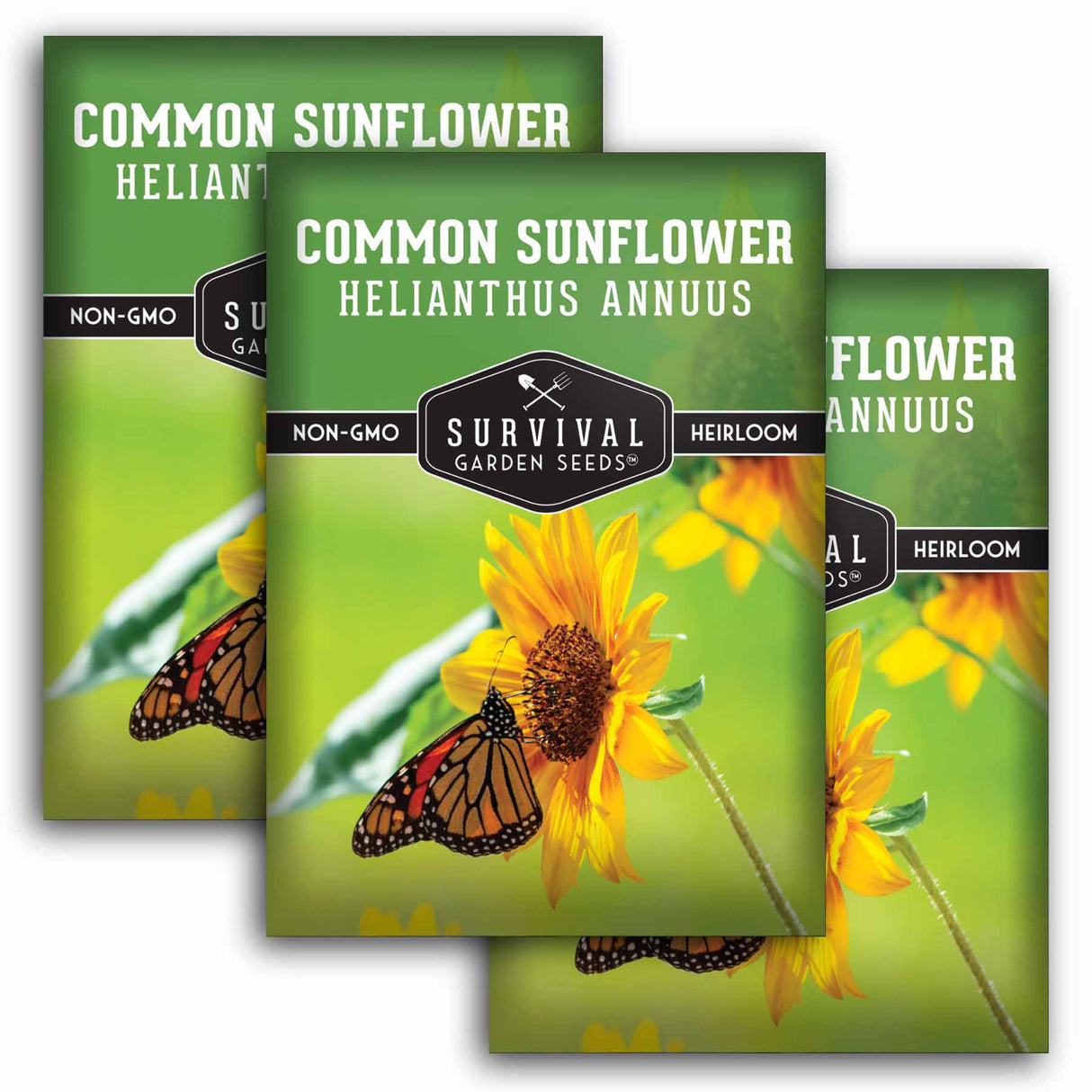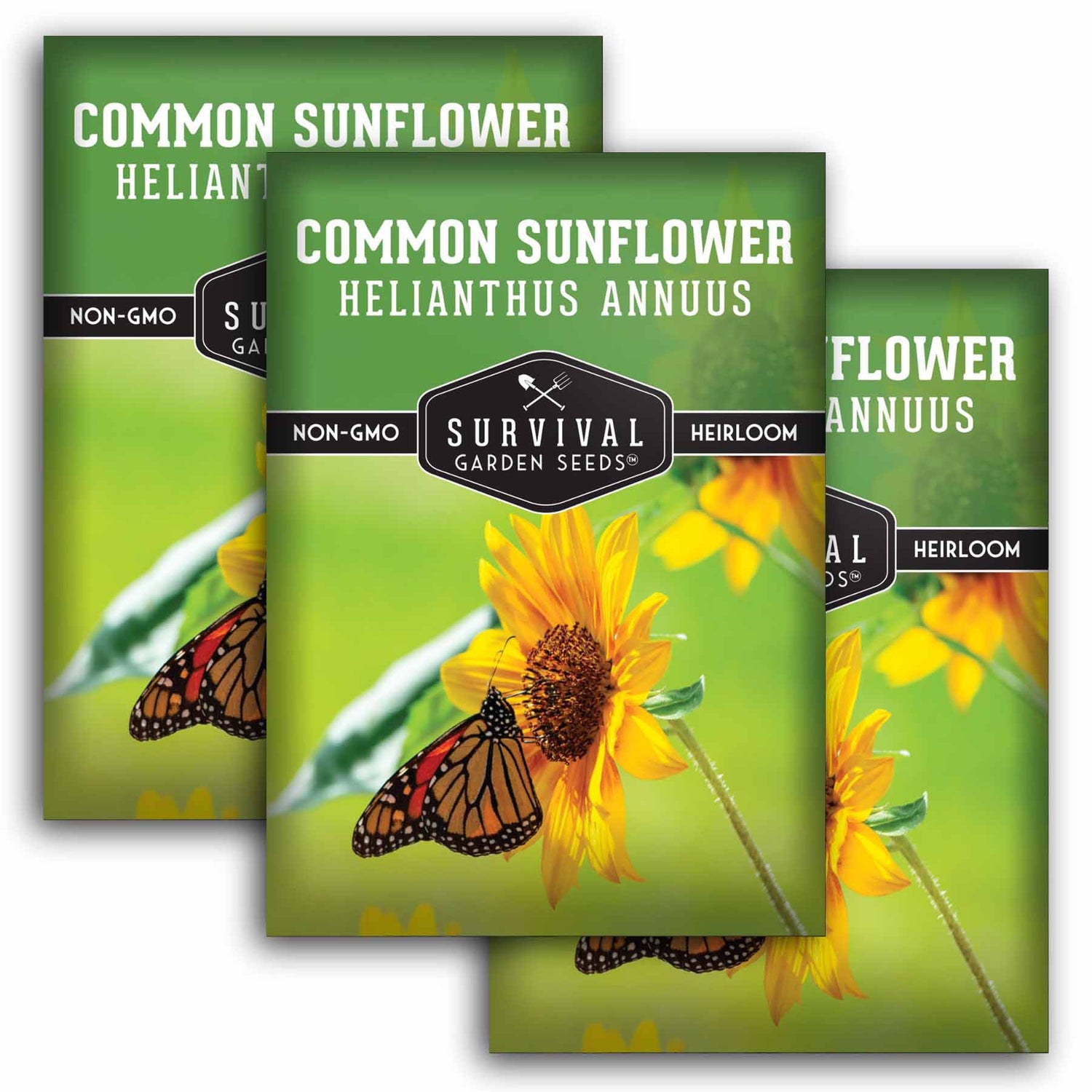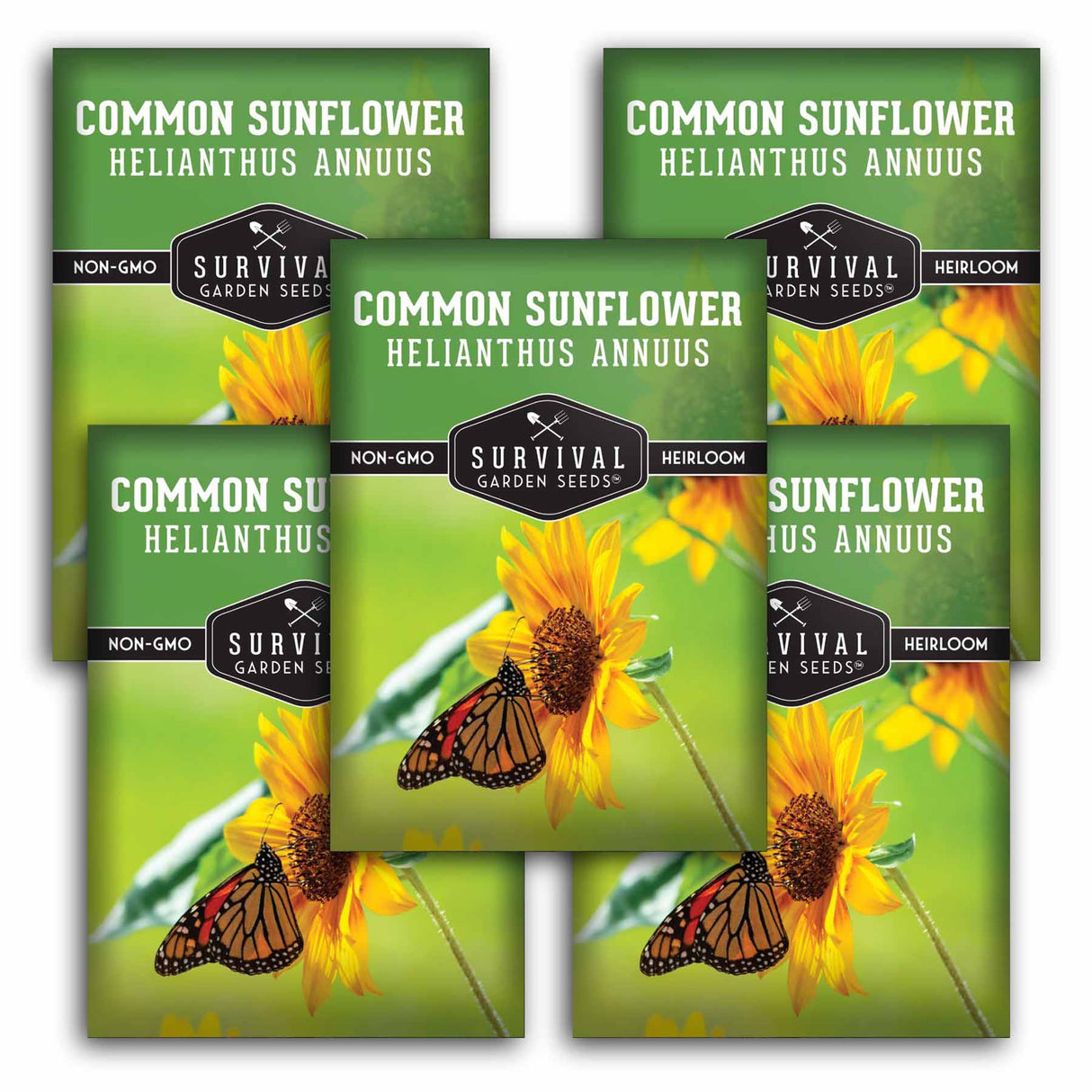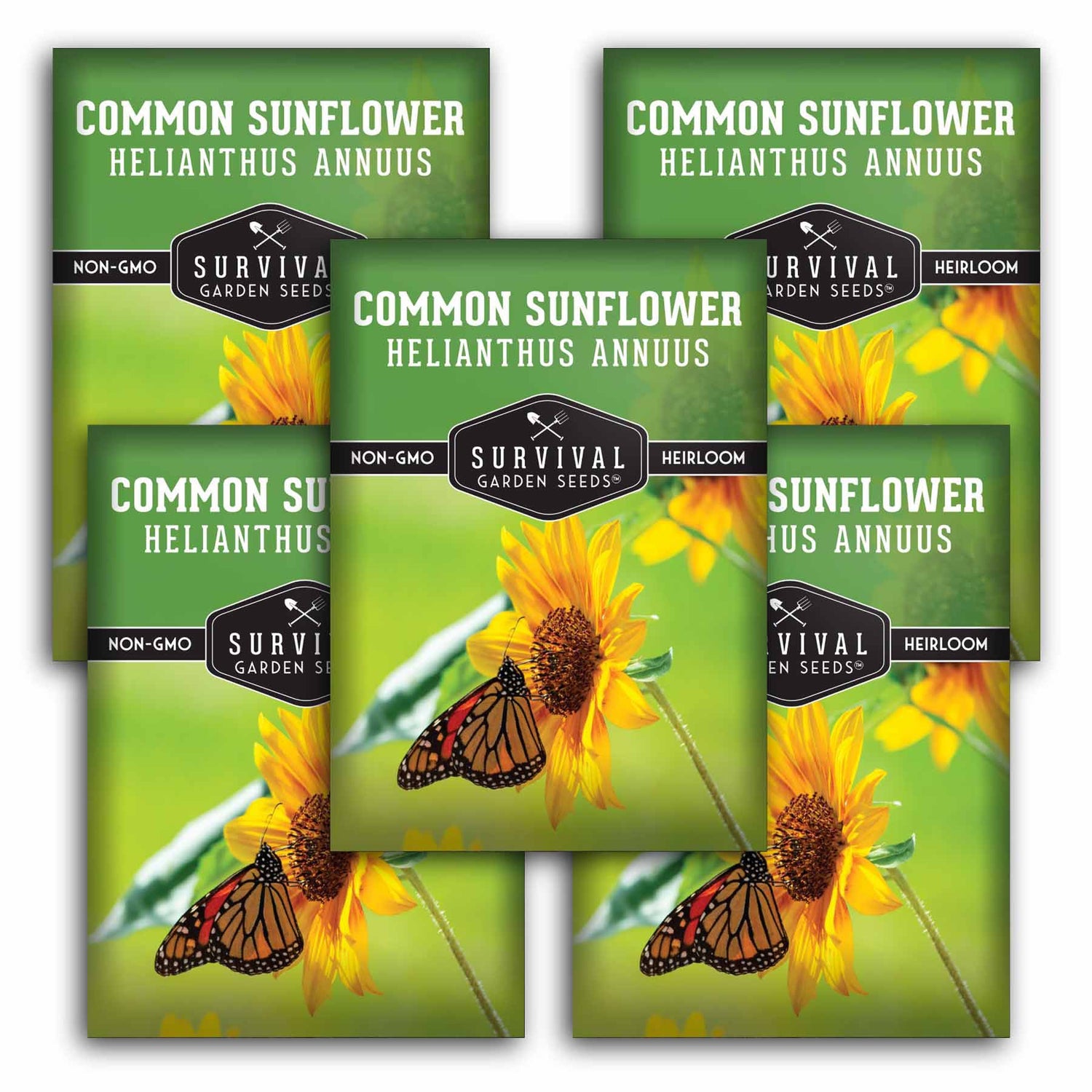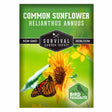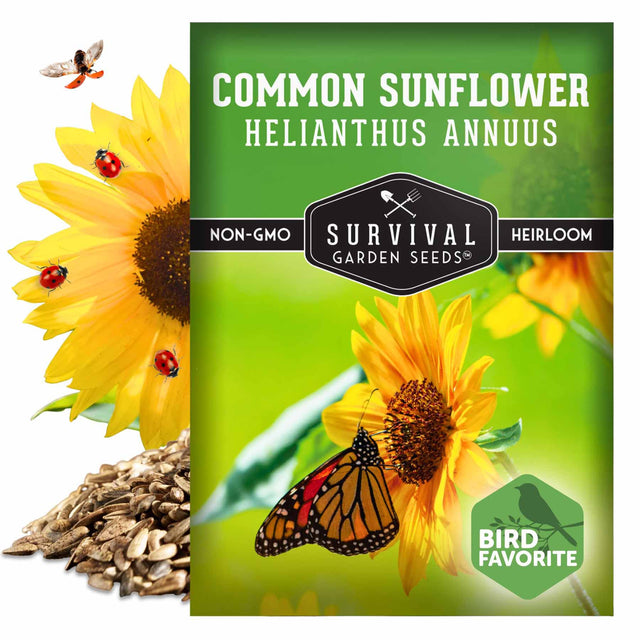Common Sunflower Seeds - Helianthus annuus
Heirloom - Non-GMO - Reliable Germination
Common Sunflower Seeds - Helianthus annuus - 1 Packet is backordered and will ship as soon as it is back in stock.
Couldn't load pickup availability
Common Sunflower brings instant joy to any garden with its iconic golden blooms that follow the sun across summer skies, creating natural focal points that can tower up to 10 feet tall. This widely-branching native wildflower produces abundant showy yellow flowers from summer through fall, transforming ordinary spaces into vibrant displays that capture the essence of American prairies and farmlands.
Unlike many modern garden sunflowers bred for uniformity and single large blooms, Common Sunflower is a true native species. It features a naturally branching habit and diverse flower sizes, making it especially valuable for pollinators and birds. Its genetic diversity supports robust ecosystems, and its oil-rich seeds nourish wildlife more effectively than many ornamental varieties.
Remarkably easy to grow and drought-resistant once established, this resilient annual thrives in full sun and adapts to clay, sand, or loam soils with minimal care. Direct sown after the last frost, seeds germinate quickly in 7-14 days and establish rapidly, making it perfect for beginning gardeners or anyone seeking reliable, low-maintenance beauty.
Common Sunflower is keystone species and a complete ecosystem plant: highly attractive to bees, birds, and butterflies while providing edible seeds, buds, petals, and leaves for human consumption. Its drought tolerance and self-seeding nature make it ideal for prairie gardens, pollinator habitats, and children's gardens.
- Iconic golden blooms reach towering heights up to 10 feet with classic yellow petals creating a stunning display from summer through fall
- Widely-branching structure produces abundant flowers on sturdy stems that withstand wind and weather, ideal for creating natural privacy screens and focal points
- All-around wildlife superstar - this true native sunflower attracts bees, butterflies, and songbirds, serves as a larval host plant for caterpillars, and provides nutritious, oil-rich seeds for winter bird feeding and even human enjoyment
- Exceptionally drought-tolerant and adaptable - thrives in clay, sand, or loam soils with minimal water once established, making it perfect for low-maintenance landscapes
- Beginner-friendly annual - seeds sprout reliably in 7-14 days with simple direct sowing, blooms prolifically in the same year allowing you to enjoy blooms immediately while waiting on slower-growing perennial native plants to establish
Heirloom Native Plant Seeds
All of our seeds are open-pollinated, non-GMO, heirloom varieties with tested germination rates
Specifications
Specifications
-
Botanical Name
-
Seasonality
-
Planting Zones
-
Light
-
Soil Temp for Germination
-
Germination Time
-
Planting Depth
-
Plant Size
-
Growing Instructions
-
Seed Saving Instructions
-
Seed Count (approximate)
Payment & Security
Your payment information is processed securely. We do not store credit card details nor have access to your credit card information.
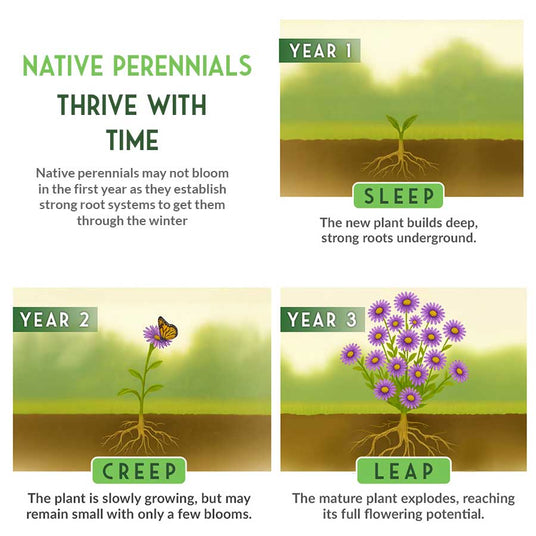
Native Perennials Are Worth The Wait!
Native perennials may not bloom in their first year. When planted from seeds, perennials put almost all of their energy into establishing strong, healthy root systems in the first year of growth. In the second year, you should see larger plants and some blooms. After the third year, you will be able to enjoy a bounty of beautiful blooms. Trust us! It will be worth the wait!
Cold Stratification Aids Germination
-
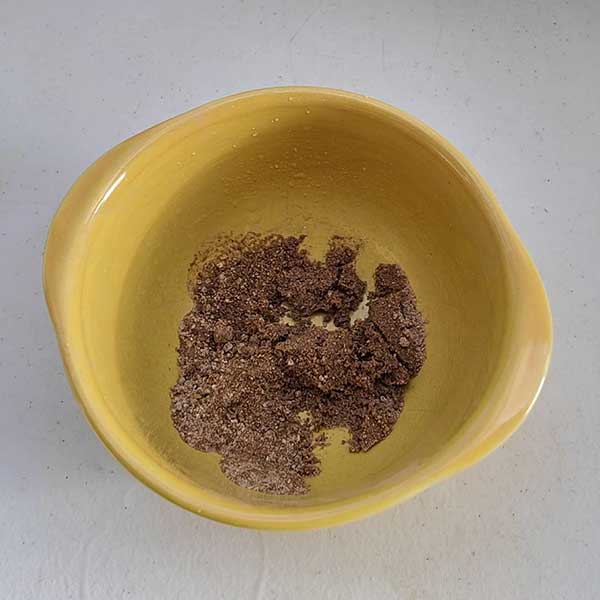
Step 1
Lightly moisten some clean sand. Make sure it is not too wet.
-
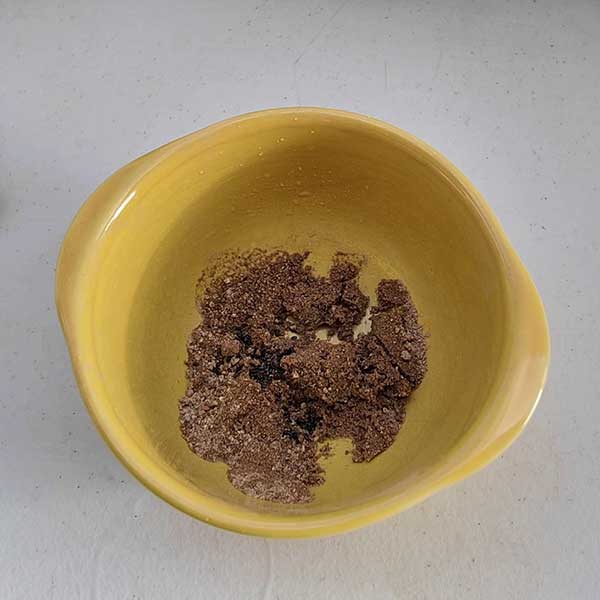
Step 2
Mix your seeds with the moist sand.
-
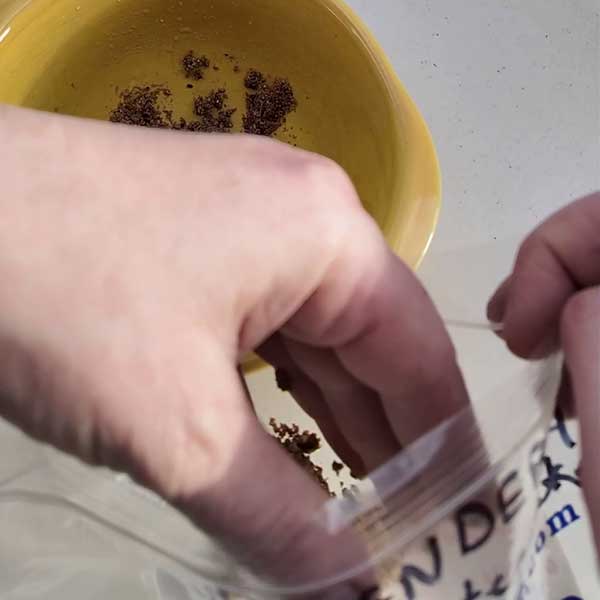
Step 3
Store your sand in an airtight container like a zip-top bag. Make sure to label and date your container.
-
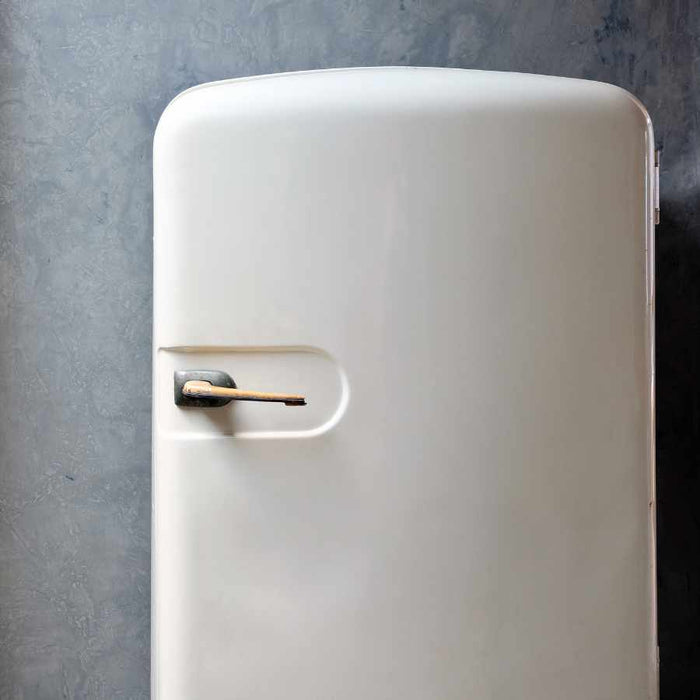
Step 4
Refrigerate your sand and seeds for 2 to 4 weeks (or more, depending on the information on your seed packet)
Support Native Habitats
- Supports Local Ecosystems and Biodiversity: Native plants are uniquely adapted to the local climate and soil conditions, forming the foundation of healthy ecosystems. They provide essential food, shelter, and breeding grounds for a wide array of native wildlife, including pollinators like bees and butterflies, birds, and beneficial insects, which helps to maintain and enhance local biodiversity.
- Requires Less Maintenance and Resources: Once established, native plants typically require significantly less water, fertilizer, and pesticides compared to non-native ornamental plants. Their deep root systems improve soil health and water penetration, reducing runoff and erosion, and their natural resistance to local pests and diseases minimizes the need for chemical interventions, saving time, money, and environmental impact.
- Contributes to Climate Resiliency and Conservation: By supporting a healthy native plant community, you are helping to create more resilient landscapes that can better withstand the impacts of climate change, such as extreme weather events. Growing native plants also plays a crucial role in conserving local plant genetics, preserving the natural heritage of a region, and providing critical habitat corridors for wildlife facing habitat loss.
- Detailed Growing Information: Paper seed packets include clear planting instructions, germination tips, and seed-saving info, great for beginner or experienced gardeners growing vegetables, herbs, flowers, or native plants.
- Trusted USA Seed Company: Family-owned business providing heirloom, non-GMO, open-pollinated seeds; always fresh, untreated, rigorously tested, and expertly packed for long-term storage and gardening success across all experience levels
Frequently Asked Questions
What are heirloom seeds?
What are heirloom seeds?
Heirloom seeds are the types of seeds your grandparents grew. These varieties have been passed down from generation to generation. They’re old reliable open-pollinated varieties that aren’t typically grown commercially. Instead, they have a rich history that predates modern breeding techniques.
You can learn more about open-pollinated, heirloom, and non-GMO seeds in our Survival Garden Training blog.
How do I know my seeds are fresh?
How do I know my seeds are fresh?
Every seed packet includes a "packed for" date, and we germination test each seed lot before packaging to ensure you receive viable, high-quality seeds that are ready to grow.
Are your seeds treated?
Are your seeds treated?
No, we do not pre-treat our farmer seeds. All of our garden seeds for sale are untreated, open-pollinated, non-GMO, and heirloom varieties. They are kept in temperature-controlled cooler storage until they are packed and shipped to keep them pest and disease-free.
In what zones can I grow your seeds?
In what zones can I grow your seeds?
The seeds in our collections are specifically chosen from varieties that can be successfully grown from Zone 3 to Zone 10 USDA Hardiness Zones. However, individual varieties have specific needs to thrive in different environments. Each seed pack has optimal temperatures for germination and instructions on seed starting. Consult local frost dates to plan your garden and get the most out of your seeds.
What is the shelf life of these gardening seeds?
What is the shelf life of these gardening seeds?
Most seeds remain viable for 3 to 5 years or longer when stored properly. Check your seed packet for specific varieties. For best results, keep your seeds in a cool, dry place away from direct sunlight and moisture. Store them in an airtight container in a consistent temperature environment—a refrigerator or cool basement works well. Proper storage helps maintain germination rates and extends seed life well beyond the packed date.
Where are Survival Garden Seeds sourced?
Where are Survival Garden Seeds sourced?
The majority of our seeds are sourced in the United States, with a few exceptions when the seed is difficult to source domestically. Whenever we do have to source outside of the US, we ensure our seeds are safe to grow, non-GMO varieties that meet our standards for germination and reliability.
